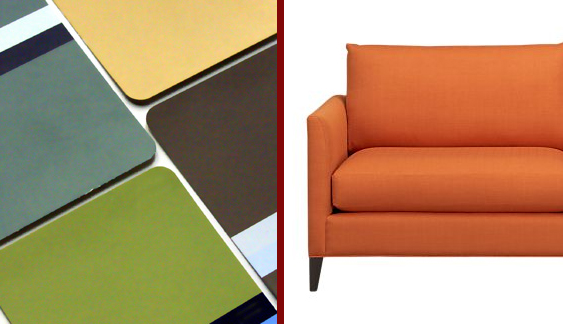
Let’s say you’re buying a house and you have a closing date a few weeks away. You’re going to buy new living room furniture, new bedding, and you’ll need new flooring too. You should pick out paint colors ASAP so the contractors can start going gangbusters before the ink is dry on your closing documents, right?
Well, that’s the fantasy.
The reality is a little tougher to sell. Picking out paint colors before sofas, rugs, chairs, bedding, curtains–all of those textiles in a room–restricts you in many ways and could be disastrous unless you’re just going to slap a coat of Builder Beige on all of the walls. And if you do that, you’re just doing your life wrong.
If you are planning to create a more personal space, you owe it to yourself to put your paint selections on the backburner. Why? Let’s say you’re hell-bent on having charcoal gray walls and a beige sofa, with a gorgeous eggplant rug. Just as the painters finish rolling on the perfect charcoal gray on the walls, you find the sofa of your dreams, and–gulp–it’s on sale. But lo, and behold, your fabulous dream sofa only comes in charcoal gray. At that point, it’s either bye-bye sofa, or you’re paying for another paint job. Either way, you lost out on an opportunity to save some money.
Here’s a more efficient process:
1. Find Your Dream House. Your offer’s accepted, YAY!
2. Contractor Cattle Call. If you’re planning to have any work done on the house or if you’re planning to work with a designer, book appointments at the new house with all of the various contractors you’ll need so you can get estimates for the work you want to complete once you take ownership of the house. Most designers have a treasure trove of contractors they can refer, so if you’re in the dark about a painter or flooring installer, your designer can help you with these contacts. The reason for ganging up all of these appointments at once is that it’s sometimes difficult to gain access to the house multiple times before your closing date. You may not have a plan in place to hand over to a contractor at this point but it’s still important to book the appointment. Not only does it give you an opportunity to meet them in person and get a feel for whether or not you’d want to work with them, but if, let’s say, you’re going to gut a bathroom, your contractor can take all of the pertinent measurements they’ll need at this appointment so they can create an estimate once you do have a plan in place. Most contractors will not provide an estimate for a job they haven’t measured themselves.
3. Spaceplanning. If you’re buying new furniture, or if you don’t know where to put your existing furniture in the new house, have a designer do some spaceplanning for you. A spaceplan is a bird’s eye view of each room, showing your existing furniture or proposed new furniture in the space, and it’s all to scale so you can see how the flow of the room will work. Spaceplans should include lighting placement and the dimensions of new furniture and rugs. Armed with this information, you can direct the movers and/or shop with confidence. You’ll know instantly whether or not the new sofa you’re looking at will fit in the space. This is also the first thing you should do if you’re planning any remodeling projects.
4. Select Remodeling Finishes. If you’re going to replace flooring or change any of the elements in the bathrooms or the kitchen, now is the time to select those finishes. Anything that gets cemented down takes priority over furnishings because that is what remains in the house if you should move. I know it’s crazy to think about moving out before you move in, but you should always, always, always consider resale.
5. Upholstery and Textiles Selections. I usually start with the biggest fabric-covered object in the room–usually the sofa–and once that is nailed down, I move on to chairs, rugs, curtains. When it comes to sofas, it may seem like there are a ton of different sofas in the world–and there are–but when you narrow the field to what will actually work in your space scale-wise, your options become more limited. This is why it makes sense to start with the sofa in a living room design plan. Once you know what fabric is going on that element, you have something to coordinate chairs to. I prefer patterns versus solid-colored chairs, so once those are chosen, you really start to get a sense for the color palette in the room. Rugs and curtains follow. In bedrooms, I start with bedding, then move on to the other textiles.
6. Paint Selection. At last–paint! Now that you know with certainty what will actually live in the space, you can gather your fabric samples together and confidently select your paint palette.
7. Casegoods and Lighting. With fabrics and paint colors in place, you can start to fill in the other furnishing gaps, like side tables and coffee tables, beds, dressers, nightstands, and of course, lamps.
8. Accessories and Art. If you’re an art aficionado, selecting what goes on the walls is every bit as important as the textiles in the room–if not more so. My approach to art is, buy what you like and then we’ll figure out where to put it. If art is more of a finishing touch for you, shop for that while you’re hunting down accessories.
If you follow this process, you will generally have less back-tracking and fewer oh-crap moments along the way. You’ll also end up with furnishings you really love, instead of stuff that just “works.”

This is AWESOME! What a simple and brilliant list. Thank you!
Great article!!